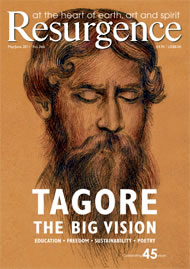As an ecologist, peace activist and town planner, the Scottish visionary Patrick Geddes planted many seeds, enhancing education and promoting international respect, all of which was given a defining focus by his work across India and his extraordinary friendship with the poet Rabindranath Tagore.
The death of his son, Alasdair, during the First World War, followed by that of his wife, gives some sense of Geddes’ emotional strength during that friendship, and of course Tagore himself was no stranger to the grief of losing both a wife and a child. As their friendship grew, Tagore wrote of Geddes: “He has the precision of the scientist and vision of the prophet; and at the same time, the power of the artist to make his ideas visible through the language of symbols”.
Philip Boardman, a student of Geddes in Montpellier, France, remarks on the extraordinary relationship of these two men in his book The Worlds of Patrick Geddes (published by Routledge & Kegan Paul in 1978): “Unlike the brief encounter with Gandhi, Geddes achieved lasting friendship and cooperation with the poet Rabindranath Tagore, dating from the Darjeeling Summer Meeting in 1917. Their closest contact, however, was in 1922–3 and concerned [Tagore’s] plans for an International University in India. Its purpose was to pave the path to a future when both the East and West will work together for the general cause of human welfare, and its official opening [was] set for January 1923. ‘I need not say’, the poet wrote already in May 1921, ‘that it would help me greatly if you could personally take part in organising it’.”
But A Meeting of Two Minds reminds us of the superhuman struggle to improve the world through education, both during and after the First World War. The two friends – the poet and the professor – wrote passionately and with conviction of cultural and economic empowerment and set in motion a political momentum which then helped illuminate the path towards self-government for India.
In their exchanges, both men asserted the importance of democratic values and mutual respect within all communities. Delving deeper into some of their correspondence in this book, its author and editor, Bashabi Fraser, reveals many of their underlying plans for the regeneration of rural communities in Bengal, including introducing training opportunities that integrated sustainable agriculture with cottage industries to imbue citizenship and self-sufficiency.
A Bengali now living in Scotland, Fraser and her family have known the Geddes family personally and also, during their formative years in Kolkata, embraced the cultural legacy and philosophy of Tagore. In compiling the book, Fraser, who is a lecturer at Edinburgh Napier University, travelled extensively to access the archives and visit the locations that were important to these two men, including destinations in France, India, Japan and Scotland.
As well as her family’s personal link with the Geddes family, Fraser says she was inspired by her own immersion in the guru-shishya (‘teacher/disciple’) philosophy embraced by both her protagonists, and her current Tagore-related ambition is to establish a Scottish Centre for Tagore Studies.
In A Meeting of Two Minds the two men’s attention to detail is revealed in many of the letters, which underpin the mood of the time and tell us so much more about the world in the first half of the 20th century. Their correspondence gives us an insight, too, into the evolving collaborative ambitions, roles and exchanges not only with the Geddes family but also with other key figures of the time, including Leonard Elmhirst, C.F. Andrews, Mahatma Gandhi and J.C. Bose, to name a few. Great care has clearly been taken with this book, which includes an explanation of the challenges overcome to decipher the material, some of which is published for the first time.
Much was achieved during the lifetimes of Tagore and Geddes, and arguably the symbolic river on which they both travelled continues to inspire and guide us even today. And what this collection of their correspondence so ably shows is that we have much to learn from both these individuals and from their vision to improve the world through education, art and science.







